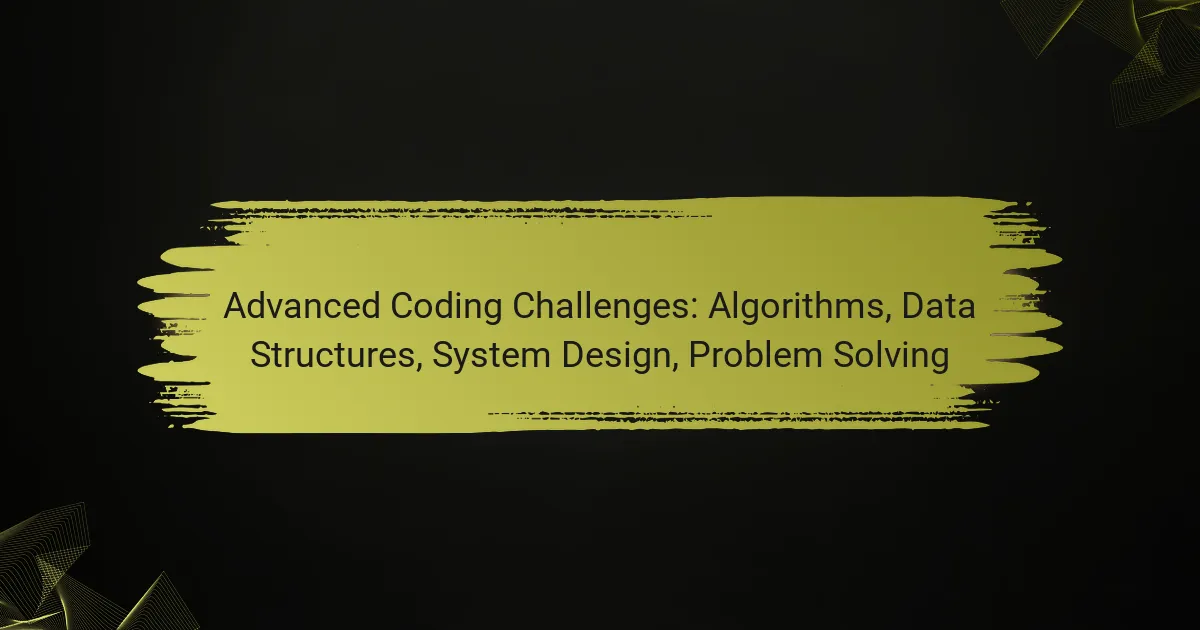Advanced coding challenges require a deep understanding of algorithms, data structures, and system design principles. Mastering techniques such as dynamic programming, graph traversal, and effective data structure selection can greatly enhance your problem-solving skills. Additionally, a solid grasp of system design concepts is crucial for articulating solutions that are both scalable and efficient in real-world applications.

What are the best algorithms for coding challenges?
The best algorithms for coding challenges often include sorting, graph traversal, dynamic programming, greedy methods, and backtracking. Each of these algorithms has unique strengths and is suited for different types of problems, making them essential tools for effective problem-solving in coding competitions.
Sorting algorithms
Sorting algorithms are fundamental for organizing data efficiently. Common types include Quick Sort, Merge Sort, and Bubble Sort, each with different time complexities and use cases. For example, Quick Sort is generally faster with an average time complexity of O(n log n), while Bubble Sort is simple but inefficient for large datasets, with a time complexity of O(n²).
When choosing a sorting algorithm, consider the size of the dataset and whether stability (preserving the order of equal elements) is necessary. For large datasets, prefer algorithms like Merge Sort or Quick Sort, while for small arrays, simpler methods like Insertion Sort may suffice.
Graph algorithms
Graph algorithms are crucial for solving problems involving networks, such as finding the shortest path or detecting cycles. Dijkstra’s and A* algorithms are popular for shortest path problems, while Depth-First Search (DFS) and Breadth-First Search (BFS) are essential for traversing graphs.
When applying graph algorithms, ensure you understand the graph’s structure (directed vs. undirected, weighted vs. unweighted) as this influences the choice of algorithm. For instance, Dijkstra’s algorithm works best with non-negative weights, while Bellman-Ford can handle negative weights but is slower.
Dynamic programming techniques
Dynamic programming (DP) is a method for solving complex problems by breaking them down into simpler subproblems and storing their solutions. This technique is particularly useful for optimization problems, such as the Knapsack problem or calculating Fibonacci numbers.
To effectively use DP, identify overlapping subproblems and optimal substructure properties. Common pitfalls include failing to define the state clearly or not considering all possible states. A typical approach involves creating a table to store solutions and iterating through possible states to build up to the final solution.
Greedy algorithms
Greedy algorithms make locally optimal choices at each step with the hope of finding a global optimum. They are efficient and straightforward, often used in problems like coin change, scheduling, and minimum spanning trees (e.g., Prim’s and Kruskal’s algorithms).
While greedy algorithms can be faster and easier to implement, they do not always guarantee the best solution. Always verify whether the problem exhibits the greedy choice property and optimal substructure before applying this method. If not, consider alternative approaches like dynamic programming.
Backtracking methods
Backtracking is a systematic way to explore all potential solutions to a problem by building candidates incrementally and abandoning those that fail to satisfy the constraints. This technique is often used in puzzles, such as Sudoku or the N-Queens problem.
When implementing backtracking, maintain a clear structure for your recursive function, including base cases and conditions for abandoning paths. This method can be computationally intensive, so pruning unnecessary branches early can significantly enhance performance.

How to approach data structures in coding challenges?
To effectively tackle data structures in coding challenges, first understand the problem requirements and constraints. Identifying the right data structure can significantly impact the efficiency and clarity of your solution.
Common data structures
Common data structures include arrays, linked lists, stacks, queues, trees, and hash tables. Each structure has unique properties that make it suitable for specific types of problems. For example, arrays allow for fast access but can be inefficient for insertions and deletions, while linked lists excel in dynamic memory allocation.
Other structures like trees and graphs are essential for hierarchical data representation and network modeling, respectively. Understanding these common data structures is crucial for selecting the right one during coding challenges.
Choosing the right data structure
Choosing the appropriate data structure depends on the operations you need to perform and the complexity of those operations. For instance, if you need to frequently access elements by index, an array may be best. Conversely, if your application requires frequent insertions and deletions, a linked list or a queue might be more efficient.
Consider the trade-offs between time complexity and space complexity when making your choice. A hash table offers average-case constant time complexity for lookups but may require more memory than an array.
Data structure operations
Data structures support various operations such as insertion, deletion, traversal, and searching. Each operation has different time complexities depending on the data structure used. For example, inserting an element in a linked list is O(1) if you have a reference to the node, while it can be O(n) for an array if resizing is required.
Familiarize yourself with the common operations and their complexities for each data structure. This knowledge will help you optimize your solutions during coding challenges and avoid common pitfalls, such as using a data structure that leads to inefficient operations.

What are effective strategies for system design interviews?
Effective strategies for system design interviews include understanding requirements, considering scalability, and applying common design patterns. These elements help candidates articulate their thought process and demonstrate their ability to create robust systems.
Understanding system requirements
Understanding system requirements is crucial for successful system design. Start by clarifying the problem statement and identifying the key functionalities needed. Engage with stakeholders to gather both functional and non-functional requirements, such as performance metrics and user expectations.
Use techniques like user stories or use cases to visualize how users will interact with the system. This helps in prioritizing features and ensuring that the design aligns with user needs.
Scalability considerations
Scalability is a key factor in system design, as it determines how well a system can handle increased loads. Consider both vertical and horizontal scaling approaches; vertical scaling involves adding resources to a single node, while horizontal scaling distributes the load across multiple nodes.
Evaluate trade-offs between consistency and availability, especially in distributed systems. Implementing caching strategies and load balancers can significantly enhance performance and responsiveness under high traffic conditions.
Common system design patterns
Familiarity with common system design patterns can streamline the design process. Patterns such as microservices, event-driven architecture, and serverless computing each offer unique benefits and challenges. For instance, microservices allow for independent deployment and scaling, while event-driven architectures can enhance responsiveness.
When selecting a pattern, consider the specific use case and the expected load. Documenting your design choices and the reasoning behind them can also provide clarity during the interview process.

How to improve problem-solving skills for coding interviews?
Improving problem-solving skills for coding interviews involves consistent practice and exposure to various coding challenges. Focus on understanding algorithms, data structures, and real-world applications to enhance your performance.
Practice platforms like LeetCode
LeetCode is a popular platform that offers a wide range of coding problems categorized by difficulty and topic. Regularly solving problems here can help you familiarize yourself with common patterns and algorithms used in interviews.
To maximize your practice, set a goal to solve a specific number of problems each week. Aim for a mix of easy, medium, and hard challenges to build confidence and tackle progressively complex scenarios.
Participating in coding competitions
Coding competitions, such as those hosted by Codeforces or HackerRank, provide an excellent opportunity to test your skills under time constraints. These events simulate the pressure of real interviews and help you develop quick thinking and problem-solving strategies.
Consider participating in at least one competition each month. This frequency allows you to assess your progress and adapt your study plan based on your performance and areas needing improvement.
Collaborative problem-solving
Working with peers on coding challenges can enhance your understanding and expose you to different problem-solving approaches. Form study groups or join online forums to discuss solutions and share insights on various algorithms and data structures.
When collaborating, focus on explaining your thought process clearly. Teaching others can reinforce your own understanding and reveal gaps in your knowledge, making it a valuable part of your preparation strategy.

What prerequisites are needed for advanced coding challenges?
To excel in advanced coding challenges, a solid foundation in programming concepts, algorithms, and data structures is essential. Familiarity with system design principles and problem-solving techniques further enhances your ability to tackle complex challenges effectively.
Foundational programming knowledge
Foundational programming knowledge includes proficiency in at least one programming language, such as Python, Java, or C++. Understanding syntax, control structures, and basic data types is crucial for writing efficient code. Familiarity with object-oriented programming concepts can also be beneficial.
In addition to language proficiency, grasping core programming paradigms—such as recursion, iteration, and functional programming—will aid in solving various problems. Practice implementing algorithms and data structures in your chosen language to build confidence and fluency.
Common pitfalls include neglecting to understand the underlying principles of algorithms and data structures. Focus on mastering the basics before moving on to more complex topics, and utilize online platforms for coding practice to reinforce your skills.


